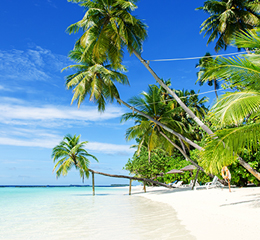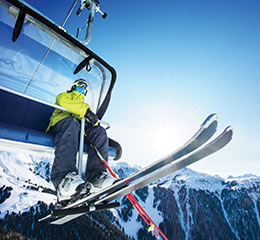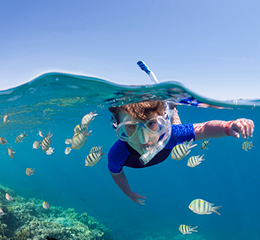Select a region (Please consider current travel restrictions)
Slovenia

Destination overview
Slovenia may only be a small country in Central Europe, but within its borders it contains Alpine mountains, thick forests, historic cities and a short Adriatic coastline. With about half the country’s land covered by dense forest, nature lovers will get their fix in this former Yugoslavian nation, from thrilling hikes in the mountains to exploring the Karstic caves which are among the most beautiful in the world. This tiny nation will satisfy the tastes of all those looking to ski the slopes, walk the woods, sample fine wine and enjoy the magnificent landscape around every bend.
Slovenia offers a pristine setting in the middle of Europe with soaring vistas of Alpine peaks, hills and dales straight out of a 19th Century landscape painting and sparkling lakes and rivers that positively light up their surroundings with their superb blues and greens. You’ll find plenty of snow-capped peaks and a wonderful Adriatic coastline as well as a culinary and cultural sophistication that is sometimes hidden behind a rural and rustic charm.
Slovenia is a fantastic outdoor destination. There are lots of great museums and historic churches here too, so there really is something for everyone to enjoy. The most popular pursuits remain mountain walks and hikes, and cycling is becoming especially popular, particularly in the capital city of Ljubljana. Fast rivers like the Soca provide excellent rafting and there are plenty of opportunities to try out activities like horse riding, ballooning, caving and diving. If all this seems a bit too energetic, you can always head to the coast and sunbathe on the Adriatic.
In the days of old Yugoslavia, Slovenia was regarded as the most open of the country’s republics, and it’s not any different today. Slovenians are proud of their country and happy to show it off and the people are very friendly and welcoming and will often reply to your questions in English.
In Slovenia, you come across different historical eras at every turn. Truly old items are preserved primarily in museums, but archaeological finds can also be seen in their natural setting. Slovenia's natural diversity further emphasises the attraction of important buildings. Slovenian castles are amazing and the many rural hilltop churches are charming. Cultural historical monuments and architectural masterpieces can be found in most Slovenian towns.
Slovenia is the only country in Europe that combines the Alps, the Mediterranean, the Pannonian Plain and the Karst. The changing landscape is constantly surprising - you can have one eye on the sea, then look in the other direction and be surrounded by high mountains. Heading up into the forests, you can see the green plains below you and from upland meadows your view stretches into river gorges. This proximity of opposites and contrasts is a hallmark of the country.
In Slovenia you can still walk through virgin forest, or watch the grapes ripen on the oldest vine in the world. The country has numerous sites of special natural interest, with features of all four main areas - the Alps, the Mediterranean, the Karst and the Pannonian Plain. It also has a wealth of diverse architecture and urban design.
Not only is the land surface very invigorating, there are also wonders underground. Some of the country’s 9,000 Karstic caves are among the most beautiful in the world with magnificent caverns and glistening stalagmite formations.
Slovenia's cultural and historical heritage is cared for and preserved with pride and includes valuable archaeological finds which can be found in the many museums across the country. Museum collections are also preserved in some Slovenian castles. Predjama Castle, built into rock and unconquered for centuries, is linked to cave tunnels and totally unique. Bled, Ljubljana and Celje Castles are three other wonderful destinations that will enthral and inspire.
Slovenian towns have well-preserved buildings in many famous architectural styles, with medieval centres beautifully conserved in numerous places. The towns are decorated with luxurious buildings, usually converted into public buildings and most coastal towns are home to magnificent palaces. Slovenian villages and the countryside are distinguished by vernacular buildings with various regions having their own specific features, including beautifully maintained manor houses.
Thousands of churches in Slovenia are the most visible sign of Christianity. Many stand on unpopulated hilltops which is a Slovenian specialty. There are more than 30 monasteries still operating in Slovenia, including five convents. One of the best known is the Cistercian monastery of Sticna, while the former Carthusian monastery in Zice is a major attraction.
Nature has been generous to Slovenia. The varied green landscape is mostly covered in forests, while grape vines are grown on the sunny slopes of hills in many areas. For those heading back to nature there are some fabulous natural parks, while Triglav National Park encompasses Slovenia’s most beautiful mountains, the Julian Alps, and is a place not to be missed. In addition to the mountain peaks, there are hills all around the country that make popular excursion destinations. You can also explore the extensive coniferous forests, such as the virgin forest at Kocevski Rog, just 60 kilometres from Ljubljana.
Slovenia’s numerous waterfalls are simply stunning and are classed as sites of special natural interest. They are most numerous in the Soca River area and in Triglav National Park.
Each year around a hundred new Karstic caves are discovered in Slovenia, but just over 20 are set up to receive visitors. The country has around 9,000 in total. The largest and the most popular is Postojna Cave, where the olm or human fish lives, while many visitors are even more taken with Skocjan Caves, which is a UNESCO World Heritage Site.
Slovenia’s coastline may be short, but it has a number of attractions. Next to Strunjan Cliff, the highest flysch wall on the Adriatic, lie the Secovlje Salt Pans, a regional park and bird sanctuary.
Several towns on the coast are also worth a visit. In addition to Piran and Portoroz, Koper and Izola are pretty destinations. The coast is ideal for water sports, while the hills of the hinterland could have been designed for biking. There are also natural health resorts in Strunjan and Portoroz.
The little town of Lipica is where breeding of the famous Lipizzaner horses began more than 400 years ago. The Lipica Stud Farm is a welcoming recreational centre and a riding school and a great place for horse lovers to visit.
Ljubljana, Slovenia’s picturesque capital city, is a definite place to include on any itinerary with its relaxed yet lively atmosphere. In the very heart of the country, it is an ideal base for getting to know the immediate surroundings and for exploring other parts of the country.
DAE Resorts in this Destination
Ready to go more places?
Discover where 7Across members are exploring.
Browse below to see some of the resorts other members have recently booked and spark your curiosity.
- Exchange
- Bonus week
- Rental




































